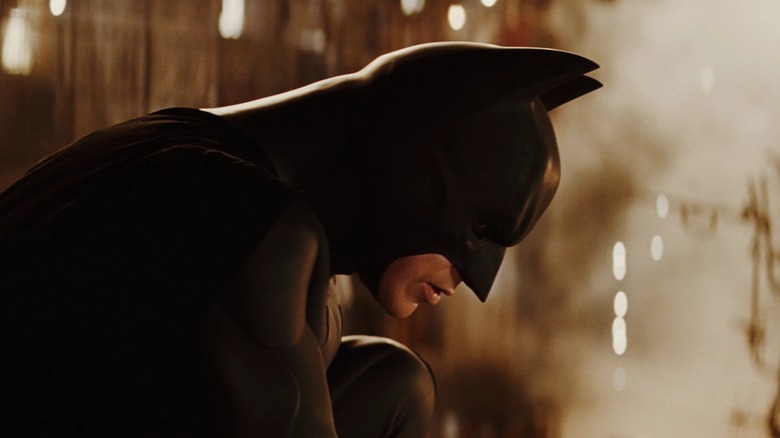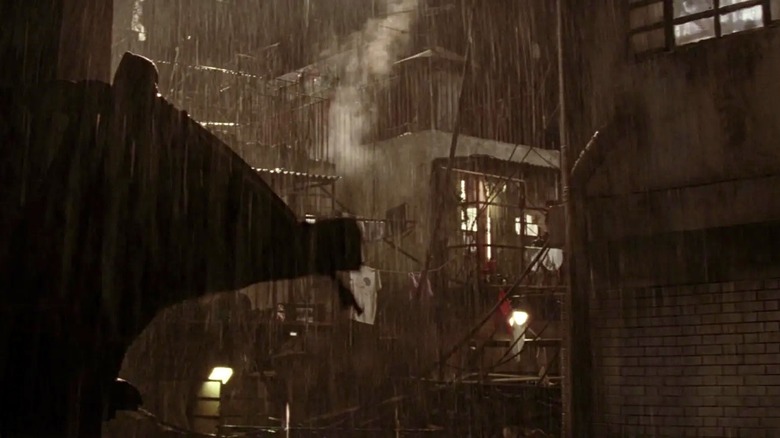Christopher Nolan Looked To Blade Runner For A Key Part Of Batman Begins
Each of the films in Christopher Nolan's "Dark Knight" trilogy carved out its own distinct look in terms of Gotham City. The cityscape in Batman's turf evolved in such a way that it was as if Gotham became every city.
Nolan and his crew shot "The Dark Knight" mostly in Chicago, using recognizable landmarks such as the Chicago Board of Trade Building as the location for Wayne Enterprises. With "The Dark Knight Rises," the production moved to places like Pittsburgh, where Heinz Field, the home stadium of the Pittsburgh Steelers, hosted the fictional Gotham Rogues football game. "The Dark Knight Rises" also filmed on the Queensboro Bridge in New York City and featured exterior shots of the island of Manhattan and buildings on Wall Street.
Before all of that, however, Nolan's Gotham existed mainly on sets and sound stages in England, where it was brought to life at Shepperton Studios and in an airship hangar in the village of Cardington, according to Movie-Locations.com. The rain-drenched slums of the Narrows in "Batman Begins" were particularly evocative of Ridley Scott's "Blade Runner," which Nolan has described as a "seminal film" for him when he was growing up. "Blade Runner" did, in fact, inspire part of the visual aesthetic of "Batman Begins," though it was more the general impression of the production design that informed Nolan's approach.
In an interview with Forbes for the 10th anniversary of "Batman Begins," Nolan said:
"It's hard to say what was conscious homage, and what was my analysis of why Blade Runner was so convincing in its production design and in the way it uses its sets. From a pragmatic point of view, Blade Runner is actually one of the most successful films of all time in terms of constructing that reality using sets. On Batman Begins, unlike The Dark Knight, we found ourselves having to build the streets of Gotham in large part. So I immediately gravitated toward the visual treatment that Ridley Scott had come up with, in terms of how you shoot these massive sets to make them feel real and not like impressive sets. And immediately we started looking at the rain, the handheld cameras, the longer lenses."
The texture of Gotham City
Nolan continued:
"So myself, my designer Nathan Crowley, and my cinematographer Wally Pfister, we started to throw all of that into the mix of how you can help the look of something, how you can create texture, as Ridley Scott has always been the absolute master of. Creating a texture to a shooting style that maximizes the impact of the set, and minimizes the artifice — the feeling that this world has edges to it that you would see at the edge of the frame. Blade Runner is one of the examples of how you can take a camera and get down and dirty ... and really envelop your audience in the atmosphere of the world you're trying to create. We definitely tried to emulate that style, and I think in doing so we actually created homage, particularly where we used the rain very much."
The Gotham of "Batman Begins" definitely has a singular texture to it, and when the camera soars in over the city, with steam rising off it, and shows Batman hanging off the side of a building in the rain, it does feel like a place that is of a piece with "Blade Runner," stylistically. While "Batman Begins" has a more brownish color palette and doesn't utilize futuristic neon or flying cars the way "Blade Runner" does, it still makes the most of the rain and the expansive, world-building feeling that "Blade Runner" had despite being confined to sets on the Warner Bros. studio backlot.
According to Box Office Mojo, "Batman Begins" was budgeted at $150 million, whereas "The Dark Knight Rises" was budgeted at $250 million. Having that extra $100 million to play with enabled Nolan to leave behind the sound stage and do more location shooting in real places. Yet more so than Chicago, Pittsburgh, or New York, the vision conjured by "Batman Begins" feels like the true Gotham City.

